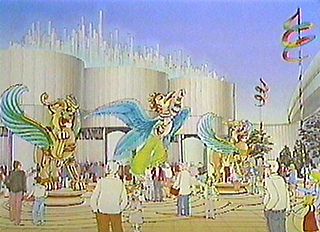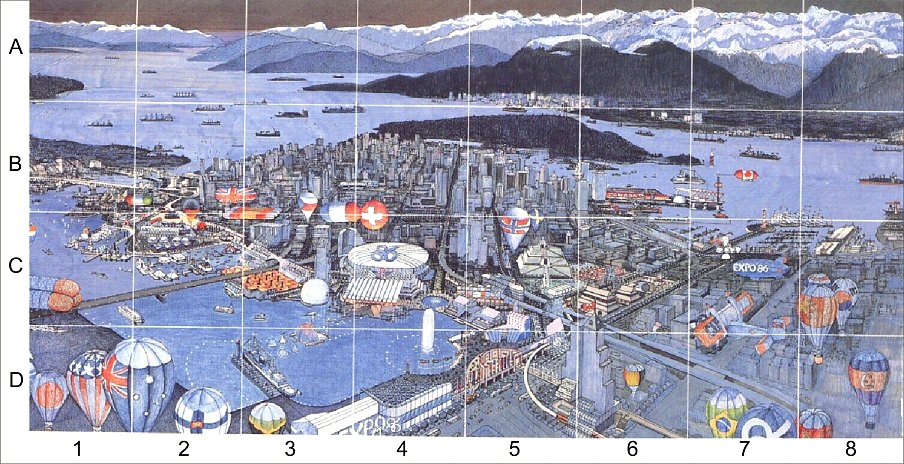
HISTORY
--
History
--
First
Drafts
--
Statistics
--
In
the News

EARLY CONCEPTUAL PLANS OF EXPO 86
THE EXPO SITE -- changed in size and shape over the years. Originally, waterfront lands stretching from the northern shores of Downtown to Gastown (B6, C6-7-8) were to be utilized for pavilions, park space, and a Marine themed plaza. Two overhead walkways (C6-7) were to join the two sites. Later, a sky ride was proposed. The idea was eventually scrapped primarily because the walkways would overlook the oldest and worst section of town. The pier housing the Canada pavilion (B6) remained.
The main site originally
extended inland to Pender Street where Expo 86 was to feature two theme
areas. A giant egyptian pyramid approximately half the size of BC
Place Stadium (C5) and as tall as 20 stories was to sit alongside the Sun
Tower to house an exhibit of ancient Egyptian treasures. The second
theme area was to consist of the largest traditional Chinese Garden outside
China (C6). A canal from False Creek to Pender St was to be dredged
in recognition of
the original canal that was part of Vancouver's landscape at the beginning
of the 20th century. Due to potential transportation/road problems,
the Canal was never realized. The chinese classical garden was built (albeit
smaller but still the largest traditional Classical
Garden outside China)
by the Vancouver Chinese community themselves. The Pyramid was not
built but the Great Hall of Ramses II pavilion which was eventually placed
on the main site housed the travelling
show of Ancient Egyptian artefacts.
EXPO CENTRE -- seen here as a white dome (C3) was originally designed as a 3/4 geodesic dome surrounded by water. Architect Bruno Freschi envisioned the dome as a spherical silver ball which would act as a 360 degree screen for several outdoor synchronized projectors. During the day, the stainless steel ball would reflect its surroundings. Later designs masked the ball with a cover of decorative scaffolding true to the high-tech architectural look of the day and Expo Centre was moved closer to the Main gate where a fountain was originally proposed.
THE FOUNTAIN --- (D4) situated where Expo Centre (Science World) now stands, was a landmark originally proposed for the end of False Creek. It was never built due to concerns that the water in False Creek was still too polluted from heavy industry and the spray landing on people during winds could cause health problems. Also, future problems due to sea water in the fountain's mechanics were addressed as being too costly to maintain in future years.
FLOATING PAVILIONS --- (C1, C2) which were to be accessed by docks were common in the original plans.


Four Theme Pavilions were originally planned. Expo Centre and the Roundhouse made it from the drawing board to construction. However, two other pavilions did not get that far. Dedicated to methods of travel in fiction, the Fantasy Transport pavilion was scrapped. In this pavilion people would have viewed such modes of travel as flying carpets and Jules Verne's time machine.


A world-wide competition
was held for the final pavilion. Architects from around the world
submitted unique and interesting designs. Although the winning submission
met the set criteria for a theme centre, it turned out not to be a pavilion
at all. It was a large outdoor sculpture called Highway 86.
|
|
